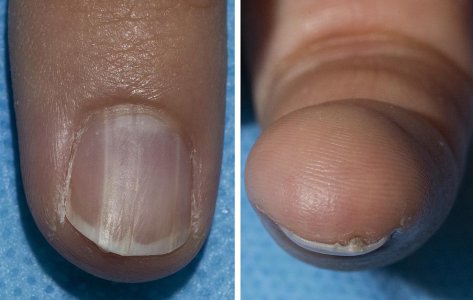Discover the hidden health warning lying in the white line on your fingernail
Disclaimer: This is not intended to be medical advice. For professional guidance, please consult your general practitioner.
When it comes to our health, sometimes the smallest signs can be harbingers of larger issues.
It's often said that the eyes are the windows to the soul, but could it be that our fingernails are the windows to our health?
Recent research suggested that a seemingly innocuous white line on your fingernail could be a subtle indicator of a much more serious condition.
The study, conducted by scientists at the National Institutes of Health (NIH), brought to light a rare genetic disorder known as BAP1 tumor predisposition syndrome.
This condition is characterised by a mutation in the BAP1 gene, which plays a crucial role in regulating cell growth and repairing DNA damage. When this gene malfunctions, it can lead to rapid and uncontrolled cell growth, resulting in tumorous masses.

What's particularly intriguing about this syndrome is its association with abnormal nail markings, including a thin white line that runs the length of the nail.
This line isn't just a cosmetic anomaly; it represents a higher level of keratinisation, which occurs when the nail is lifted or distorted by a tumour underneath.
In the NIH study, 41 out of 47 individuals exhibited an abnormal line on a nail, and upon further investigation, it was discovered that 39 of them had a benign tumour.
Out of the participants with BAP1 tumour predisposition syndrome, 87.2 per cent exhibited these nail changes, most notably onychopapilloma, a type of benign tumour that affects the production and distribution of keratin.
The presence of these white lines and the accompanying thickened skin under the nail could be a sign of onychopapilloma, which, while benign, is a hallmark of the BAP1 syndrome.
Alexandra Lebensohn, a researcher at the National Cancer Institute, who assisted with the study, stated, ‘When asked about nail health during a baseline genetic assessment, a very astute patient reported that he had noticed subtle changes in his nail.’
‘His comment prompted us to systematically evaluate other participants for nail changes and uncover this new finding.’
This syndrome significantly increases the risk of several types of cancer, including a rare form of eye cancer known as uveal melanoma, mesothelioma (a cancer affecting the lining of internal organs), and kidney cancer.
It's important to note that BAP1 tumour predisposition syndrome is quite rare, with fewer than 100 families worldwide known to carry the genetic mutation.
However, for those who do have the syndrome, the associated cancers tend to be more aggressive and manifest earlier in life.
For instance, the average age of onset for malignant mesothelioma in predisposed individuals is 55 years, compared to 72 years in the general population.
‘We believe the presence of nail changes that suggest onychopapillomas on multiple nails should prompt consideration of a diagnosis of BAP1 tumour predisposition syndrome,’ Dr Edward Cowen, a dermatologist at the NIH's National Institute of Arthritis and Musculoskeletal and Skin Diseases, stated.
The discovery of the link between nail changes and BAP1 syndrome was somewhat serendipitous.
A patient's comment about subtle changes in his nails prompted researchers to systematically evaluate other participants for similar nail changes, leading to this groundbreaking finding.
The research, published in JAMA Dermatology, emphasises the importance of paying attention to even the smallest changes in our bodies.
For our readers over 60, this information is particularly pertinent. As we age, we may become more susceptible to various health issues, and being vigilant about changes in our bodies is crucial.
If you notice a persistent white line running the length of your nail, or any other unusual nail changes, it's advisable to consult with a healthcare professional. While it may be nothing to worry about, it's always better to err on the side of caution.
In the meantime, maintaining a healthy lifestyle, including a balanced diet, regular exercise, and avoiding known carcinogens like tobacco, can help reduce the risk of cancer.
And remember, knowledge is power—staying informed about potential health risks allows us to take proactive steps in managing our well-being.
 We invite you to share your thoughts and experiences. Have you ever noticed any unusual changes in your nails? How do you stay on top of your health as you age? Share your tips in the comments below!
We invite you to share your thoughts and experiences. Have you ever noticed any unusual changes in your nails? How do you stay on top of your health as you age? Share your tips in the comments below!
When it comes to our health, sometimes the smallest signs can be harbingers of larger issues.
It's often said that the eyes are the windows to the soul, but could it be that our fingernails are the windows to our health?
Recent research suggested that a seemingly innocuous white line on your fingernail could be a subtle indicator of a much more serious condition.
The study, conducted by scientists at the National Institutes of Health (NIH), brought to light a rare genetic disorder known as BAP1 tumor predisposition syndrome.
This condition is characterised by a mutation in the BAP1 gene, which plays a crucial role in regulating cell growth and repairing DNA damage. When this gene malfunctions, it can lead to rapid and uncontrolled cell growth, resulting in tumorous masses.

Recent research suggested that nails could show indications of a serious medical condition. Image source: NIH
What's particularly intriguing about this syndrome is its association with abnormal nail markings, including a thin white line that runs the length of the nail.
This line isn't just a cosmetic anomaly; it represents a higher level of keratinisation, which occurs when the nail is lifted or distorted by a tumour underneath.
In the NIH study, 41 out of 47 individuals exhibited an abnormal line on a nail, and upon further investigation, it was discovered that 39 of them had a benign tumour.
Out of the participants with BAP1 tumour predisposition syndrome, 87.2 per cent exhibited these nail changes, most notably onychopapilloma, a type of benign tumour that affects the production and distribution of keratin.
The presence of these white lines and the accompanying thickened skin under the nail could be a sign of onychopapilloma, which, while benign, is a hallmark of the BAP1 syndrome.
Alexandra Lebensohn, a researcher at the National Cancer Institute, who assisted with the study, stated, ‘When asked about nail health during a baseline genetic assessment, a very astute patient reported that he had noticed subtle changes in his nail.’
‘His comment prompted us to systematically evaluate other participants for nail changes and uncover this new finding.’
This syndrome significantly increases the risk of several types of cancer, including a rare form of eye cancer known as uveal melanoma, mesothelioma (a cancer affecting the lining of internal organs), and kidney cancer.
It's important to note that BAP1 tumour predisposition syndrome is quite rare, with fewer than 100 families worldwide known to carry the genetic mutation.
However, for those who do have the syndrome, the associated cancers tend to be more aggressive and manifest earlier in life.
For instance, the average age of onset for malignant mesothelioma in predisposed individuals is 55 years, compared to 72 years in the general population.
‘We believe the presence of nail changes that suggest onychopapillomas on multiple nails should prompt consideration of a diagnosis of BAP1 tumour predisposition syndrome,’ Dr Edward Cowen, a dermatologist at the NIH's National Institute of Arthritis and Musculoskeletal and Skin Diseases, stated.
The discovery of the link between nail changes and BAP1 syndrome was somewhat serendipitous.
A patient's comment about subtle changes in his nails prompted researchers to systematically evaluate other participants for similar nail changes, leading to this groundbreaking finding.
The research, published in JAMA Dermatology, emphasises the importance of paying attention to even the smallest changes in our bodies.
For our readers over 60, this information is particularly pertinent. As we age, we may become more susceptible to various health issues, and being vigilant about changes in our bodies is crucial.
If you notice a persistent white line running the length of your nail, or any other unusual nail changes, it's advisable to consult with a healthcare professional. While it may be nothing to worry about, it's always better to err on the side of caution.
In the meantime, maintaining a healthy lifestyle, including a balanced diet, regular exercise, and avoiding known carcinogens like tobacco, can help reduce the risk of cancer.
And remember, knowledge is power—staying informed about potential health risks allows us to take proactive steps in managing our well-being.
Key Takeaways
- A study by the National Institutes of Health showed that long white lines on fingernails can indicate a higher risk of kidney and other cancers due to a genetic disorder called BAP1 tumour predisposition syndrome.
- This rare genetic condition, which affects a gene that regulates cell growth and repairs DNA damage, is associated with onychopapilloma, a benign tumor that manifests as white lines on the nails.
- The majority of study participants with the syndrome had these white lines on their nails and were also found to have benign tumours in their nail beds.
- BAP1 tumour predisposition syndrome is linked to a range of cancers, including a type of eye cancer called uveal melanoma, mesothelioma, and kidney cancer, and is known to occur in fewer than 100 families worldwide.






